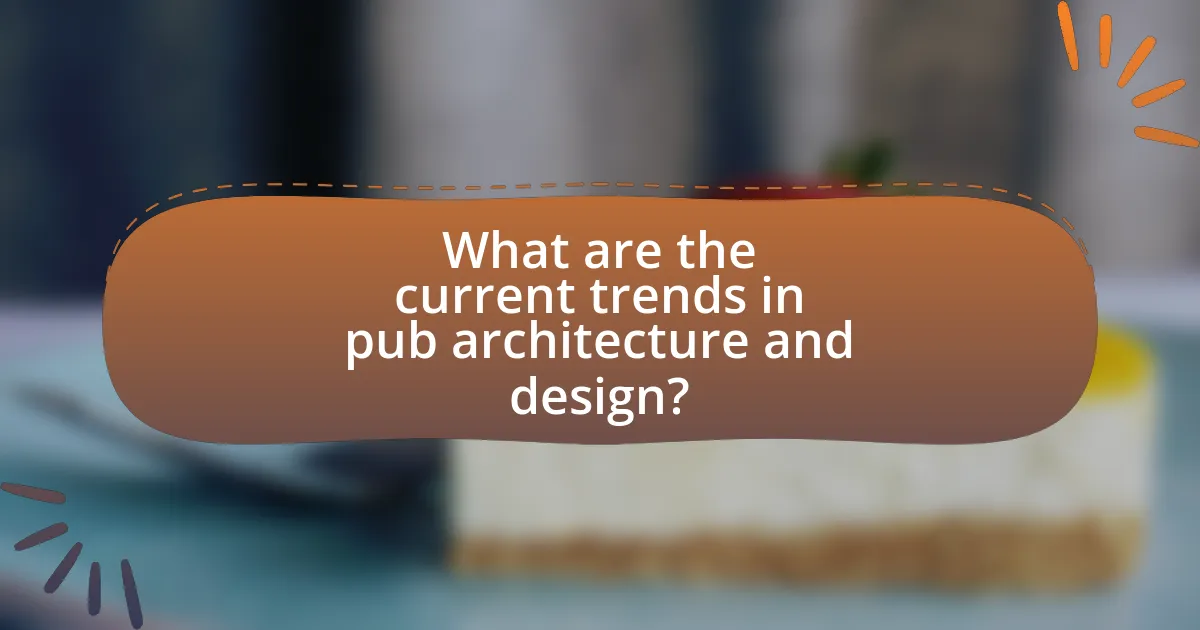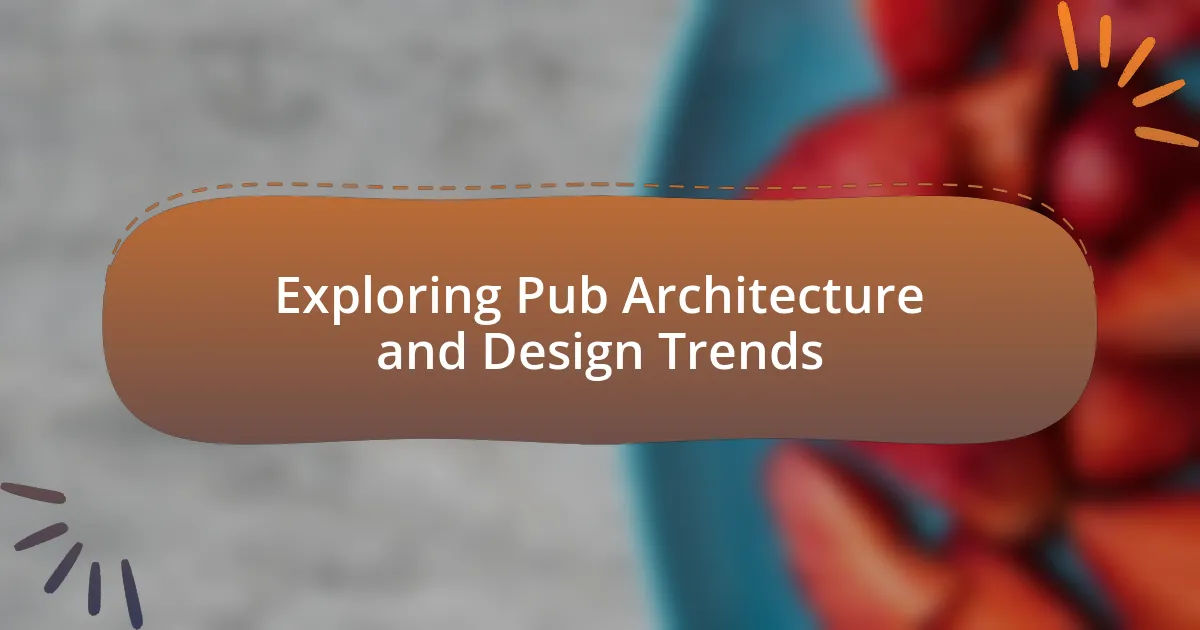The article focuses on the key elements of pub architecture and design, highlighting aspects such as layout, materials, lighting, and ambiance that contribute to the social experience of pubs. It examines how historical context influences design choices, the architectural styles commonly found in pubs, and the impact of local materials on construction. Additionally, the article discusses the importance of functionality, customer experience, and essential facilities in modern pubs, along with current trends emphasizing sustainability and community integration. Emerging design concepts, the role of technology, and strategies for creating a unique identity through design are also explored, providing a comprehensive overview of contemporary pub architecture and design trends.

What are the key elements of pub architecture and design?
The key elements of pub architecture and design include layout, materials, lighting, and ambiance. The layout typically features an open floor plan that encourages social interaction, often with a central bar area and various seating arrangements. Materials such as wood, brick, and stone are commonly used to create a warm and inviting atmosphere, reflecting traditional pub aesthetics. Lighting plays a crucial role, with a mix of natural light during the day and softer, ambient lighting in the evening to enhance the social experience. Additionally, the overall ambiance is designed to foster a sense of community, often incorporating local artwork or historical elements that connect the pub to its surroundings. These elements collectively contribute to the unique character and functionality of pubs, making them central to social gatherings.
How does the historical context influence pub design?
Historical context significantly influences pub design by shaping architectural styles, materials, and social functions. For instance, the Victorian era in the 19th century led to the creation of ornate pubs featuring intricate woodwork and stained glass, reflecting the period’s emphasis on craftsmanship and social gathering. Additionally, the rise of the industrial revolution prompted the incorporation of larger spaces and functional layouts to accommodate the working class, as seen in the design of public houses that prioritized accessibility and communal areas. These historical influences are evident in the preservation of traditional elements in modern pubs, which often blend contemporary aesthetics with historical features to maintain cultural relevance and appeal to patrons.
What architectural styles are commonly found in pubs?
Common architectural styles found in pubs include Victorian, Georgian, and contemporary designs. Victorian pubs, prevalent in the 19th century, often feature ornate detailing, large windows, and intricate woodwork. Georgian pubs, dating back to the 18th century, are characterized by symmetry, brick facades, and classical elements. Contemporary pubs may incorporate modern materials and open layouts, reflecting current design trends. These styles are significant as they represent the historical and cultural evolution of public houses, influencing their aesthetic and functional aspects.
How do local materials impact pub construction?
Local materials significantly impact pub construction by influencing design aesthetics, structural integrity, and sustainability. The use of locally sourced stone, timber, or brick can enhance the visual appeal of a pub, making it blend harmoniously with its surroundings. For instance, pubs built with local stone often reflect regional architectural styles, fostering a sense of place and community identity. Additionally, local materials can improve structural performance; for example, timber from local forests may provide better insulation and durability suited to the local climate. Furthermore, utilizing local materials reduces transportation costs and carbon emissions, aligning with sustainable building practices. Studies show that buildings using local materials can achieve higher energy efficiency ratings, contributing to lower operational costs over time.
What role does functionality play in pub design?
Functionality is crucial in pub design as it directly influences customer experience and operational efficiency. A well-designed pub must accommodate various activities, such as dining, socializing, and entertainment, while ensuring smooth service flow. For instance, the layout should facilitate easy movement for both patrons and staff, minimizing congestion and enhancing service speed. Research indicates that pubs with effective functional designs can increase customer satisfaction by up to 30%, as they provide comfortable seating arrangements, accessible restrooms, and designated areas for different activities. This focus on functionality not only improves the overall ambiance but also contributes to higher customer retention and profitability.
How is space utilized for customer experience in pubs?
Space in pubs is utilized to enhance customer experience through strategic layout, ambiance, and functional zones. The arrangement of seating areas, such as communal tables and cozy nooks, encourages social interaction while providing privacy options. Additionally, the use of lighting and decor creates an inviting atmosphere that influences mood and comfort. For instance, research indicates that well-designed spaces can increase customer satisfaction by up to 20%, highlighting the importance of thoughtful design in enhancing the overall experience.
What are the essential facilities that modern pubs must include?
Modern pubs must include essential facilities such as a well-stocked bar, comfortable seating areas, restrooms, and a kitchen for food service. These facilities cater to customer needs and enhance the overall experience. A well-stocked bar ensures a variety of beverage options, while comfortable seating promotes social interaction. Adequate restrooms are crucial for hygiene and convenience, and a kitchen allows for food offerings, which can significantly increase customer satisfaction and revenue. According to industry standards, these facilities are fundamental for operational efficiency and customer retention in the competitive pub market.
Why is ambiance important in pub architecture?
Ambiance is crucial in pub architecture because it directly influences customer experience and satisfaction. A well-designed ambiance can create a welcoming atmosphere that encourages patrons to stay longer, socialize, and return. Research indicates that elements such as lighting, color schemes, and spatial layout significantly affect mood and behavior; for instance, a study published in the Journal of Environmental Psychology found that warm lighting and comfortable seating can enhance relaxation and social interaction in dining environments. Therefore, effective ambiance in pub architecture not only attracts customers but also fosters a vibrant social environment that can lead to increased revenue and customer loyalty.
How do lighting and color schemes affect the atmosphere?
Lighting and color schemes significantly influence the atmosphere of a space by affecting mood and perception. Warm lighting and earthy color palettes create a cozy and inviting environment, while cool lighting and vibrant colors can energize and stimulate social interaction. Research indicates that specific color temperatures, such as warm white light (around 2700K), can enhance feelings of comfort and relaxation, making patrons feel more at ease in a pub setting. Additionally, studies show that colors like red and yellow can increase appetite and encourage conversation, further shaping the overall experience in hospitality environments.
What design elements contribute to a welcoming environment?
Design elements that contribute to a welcoming environment include warm lighting, comfortable seating, and open layouts. Warm lighting creates an inviting atmosphere by reducing harsh shadows and enhancing the overall ambiance, which studies show can improve mood and social interaction. Comfortable seating encourages patrons to linger, fostering a sense of community and relaxation, while open layouts facilitate movement and interaction among guests, making spaces feel more inclusive. Additionally, incorporating natural elements like plants can enhance the aesthetic appeal and promote well-being, as research indicates that greenery can reduce stress and increase comfort levels in social settings.

What are the current trends in pub architecture and design?
Current trends in pub architecture and design emphasize sustainability, community integration, and multifunctional spaces. Sustainable practices include the use of reclaimed materials, energy-efficient systems, and green roofs, which not only reduce environmental impact but also appeal to eco-conscious patrons. Community integration is evident in designs that reflect local culture and history, fostering a sense of belonging. Additionally, multifunctional spaces are becoming popular, allowing pubs to serve as venues for various activities, such as live music, art exhibitions, and community events, thereby increasing their utility and attracting diverse clientele. These trends are supported by industry reports indicating a growing consumer preference for environmentally friendly and socially responsible establishments.
How are sustainability practices shaping modern pub designs?
Sustainability practices are significantly shaping modern pub designs by prioritizing eco-friendly materials, energy efficiency, and waste reduction. Many contemporary pubs incorporate reclaimed wood, recycled metals, and sustainable textiles to minimize environmental impact. For instance, the use of energy-efficient lighting and HVAC systems reduces energy consumption, aligning with the growing demand for environmentally responsible establishments. Additionally, many pubs are adopting water-saving fixtures and implementing composting and recycling programs to manage waste effectively. These practices not only enhance the pub’s appeal to environmentally conscious consumers but also contribute to long-term operational cost savings, demonstrating a clear trend towards sustainability in the hospitality industry.
What eco-friendly materials are being used in pub construction?
Eco-friendly materials used in pub construction include reclaimed wood, bamboo, recycled metal, and low-VOC (volatile organic compounds) paints. Reclaimed wood reduces deforestation and utilizes existing materials, while bamboo is a rapidly renewable resource known for its strength and sustainability. Recycled metal, often sourced from old buildings or industrial sites, minimizes waste and energy consumption in production. Low-VOC paints contribute to better indoor air quality and reduce harmful emissions. These materials collectively support sustainable building practices and align with growing environmental awareness in the hospitality industry.
How do energy-efficient designs benefit pub operations?
Energy-efficient designs significantly benefit pub operations by reducing operational costs and enhancing sustainability. These designs often incorporate energy-saving technologies such as LED lighting, high-efficiency HVAC systems, and improved insulation, which collectively lower energy consumption. For instance, a study by the U.S. Department of Energy found that energy-efficient upgrades can reduce energy costs by 20-50%, directly impacting a pub’s bottom line. Additionally, energy-efficient designs can improve customer comfort and satisfaction, leading to increased patronage and loyalty. By adopting these practices, pubs not only save money but also contribute to environmental sustainability, aligning with the growing consumer preference for eco-friendly establishments.
What technological advancements are influencing pub design?
Technological advancements influencing pub design include the integration of smart technology, sustainable materials, and advanced lighting systems. Smart technology, such as automated ordering systems and digital menus, enhances customer experience and operational efficiency. Sustainable materials, like recycled wood and energy-efficient appliances, are increasingly used to reduce environmental impact. Advanced lighting systems, including LED and smart lighting controls, create dynamic atmospheres that can be adjusted for different times of day or events. These advancements reflect a growing trend towards creating more efficient, environmentally friendly, and customer-centric pub environments.
How is smart technology integrated into pub environments?
Smart technology is integrated into pub environments through the use of automated systems, digital ordering platforms, and smart lighting solutions. Automated systems, such as smart taps and inventory management software, streamline operations by monitoring stock levels and reducing waste. Digital ordering platforms enable customers to place orders via mobile apps or tablets, enhancing the customer experience and increasing efficiency. Smart lighting solutions adjust ambiance based on occupancy and time of day, improving energy efficiency and creating a welcoming atmosphere. These integrations not only enhance operational efficiency but also improve customer satisfaction and engagement in modern pub settings.
What role does social media play in the design of modern pubs?
Social media significantly influences the design of modern pubs by shaping customer expectations and enhancing brand visibility. Pubs now incorporate Instagrammable features, such as aesthetically pleasing interiors and unique decor, to attract social media users who share their experiences online. According to a survey by the National Restaurant Association, 30% of consumers reported that they choose dining locations based on social media presence, highlighting the importance of visual appeal in pub design. Additionally, social media platforms serve as feedback channels, allowing pub owners to adapt their designs based on customer preferences and trends, further integrating digital engagement into the physical space.
What are the emerging design concepts in the pub industry?
Emerging design concepts in the pub industry include sustainable architecture, multifunctional spaces, and immersive experiences. Sustainable architecture focuses on eco-friendly materials and energy-efficient designs, reflecting a growing consumer preference for environmentally responsible establishments. Multifunctional spaces allow pubs to serve various purposes, such as dining, entertainment, and social gatherings, maximizing utility and attracting diverse clientele. Immersive experiences, often enhanced by technology, engage patrons through interactive elements and themed environments, creating memorable visits. These trends are supported by industry reports indicating a shift towards more adaptable and environmentally conscious pub designs.
How are open-concept layouts changing the pub experience?
Open-concept layouts are transforming the pub experience by fostering a more social and interactive environment. These layouts eliminate physical barriers, encouraging patrons to engage with one another and staff, which enhances the overall atmosphere. Research indicates that open spaces can increase customer satisfaction and dwell time, as they promote a sense of community and inclusivity. For instance, a study published in the Journal of Hospitality and Tourism Research found that venues with open layouts reported a 20% increase in customer interactions compared to traditional designs. This shift not only attracts a diverse clientele but also supports a dynamic and lively pub culture.
What unique themes are becoming popular in pub design?
Unique themes becoming popular in pub design include sustainability, local culture, and immersive experiences. Sustainability is emphasized through eco-friendly materials and energy-efficient systems, reflecting a growing consumer preference for environmentally responsible establishments. Local culture is showcased by incorporating regional art, history, and culinary traditions, creating a sense of community and authenticity. Immersive experiences are designed to engage patrons through interactive elements, themed decor, and unique atmospheres that enhance social interactions. These trends are supported by industry reports indicating a shift towards personalized and meaningful dining experiences, aligning with consumer desires for connection and environmental consciousness.

How can pub owners effectively implement design trends?
Pub owners can effectively implement design trends by conducting thorough market research to identify current preferences and integrating those insights into their space. This approach allows pub owners to create an environment that resonates with their target audience, enhancing customer experience and engagement. For instance, a study by the American Institute of Architects indicates that incorporating sustainable materials and open layouts can significantly improve patron satisfaction and increase foot traffic. By staying updated on design trends through industry publications and attending trade shows, pub owners can ensure their establishments remain relevant and appealing.
What are the best practices for renovating an existing pub?
The best practices for renovating an existing pub include assessing the current layout, enhancing the ambiance, updating facilities, and ensuring compliance with regulations. First, evaluating the existing space allows for identifying areas that require improvement or reconfiguration to optimize flow and customer experience. Enhancing the ambiance through lighting, decor, and furniture can significantly impact customer satisfaction and retention. Updating facilities, such as restrooms and kitchen equipment, ensures that the pub meets modern standards and improves operational efficiency. Lastly, adhering to local building codes and health regulations is crucial to avoid legal issues and ensure safety. These practices are supported by industry trends that emphasize customer experience and operational efficiency in pub renovations.
How can owners balance tradition with modern design elements?
Owners can balance tradition with modern design elements by integrating classic architectural features with contemporary materials and layouts. For instance, maintaining original structural elements like exposed beams or brick walls while incorporating sleek furniture and modern lighting can create a harmonious blend. Historical pubs often feature rich woodwork and ornate details; owners can preserve these aspects while updating color schemes and adding minimalist decor to appeal to modern tastes. This approach not only respects the heritage of the space but also attracts a diverse clientele, as evidenced by successful renovations in pubs across the UK that have maintained their traditional charm while embracing modern aesthetics.
What steps should be taken to ensure a successful redesign?
To ensure a successful redesign, conduct thorough research on current design trends and customer preferences. This involves analyzing competitor designs, gathering feedback from patrons, and understanding the target demographic’s needs. Engaging with stakeholders, including staff and customers, can provide valuable insights that inform the redesign process. Additionally, creating a clear design brief that outlines objectives, budget, and timelines is essential for guiding the project. Implementing a phased approach allows for adjustments based on feedback during the redesign, ensuring that the final outcome aligns with both aesthetic goals and functional requirements. Historical data shows that establishments that prioritize customer input in their redesigns see a 20% increase in customer satisfaction and retention.
How can pub owners create a unique identity through design?
Pub owners can create a unique identity through design by incorporating distinctive architectural elements, themed decor, and personalized branding. For instance, utilizing local materials and historical references in the building’s facade can establish a strong connection to the community, making the pub memorable. Additionally, a cohesive theme, such as a vintage or industrial style, can enhance the overall atmosphere and appeal to target demographics. Research indicates that establishments with a strong visual identity can increase customer loyalty and attract new patrons, as seen in a study by the Journal of Hospitality and Tourism Research, which found that unique design elements significantly influence consumer perceptions and choices.
What strategies can be used to reflect local culture in pub design?
To reflect local culture in pub design, incorporating regional materials, artwork, and historical references is essential. Utilizing locally sourced materials, such as wood or stone, connects the pub to its geographical context, while displaying local artwork or crafts can celebrate the community’s artistic heritage. Additionally, integrating design elements that reference local history, such as architectural styles or motifs, can create a sense of place. For instance, pubs in coastal areas might feature nautical themes, while those in rural settings could emphasize agricultural elements. These strategies not only enhance the aesthetic appeal but also foster a deeper connection between the establishment and its patrons, reinforcing community identity.
How can branding be integrated into the architectural design of a pub?
Branding can be integrated into the architectural design of a pub by incorporating visual elements that reflect the brand’s identity, such as logos, color schemes, and thematic decor. For instance, the use of specific materials, signage, and layout can create an atmosphere that aligns with the brand’s message and target audience. Research indicates that cohesive branding in physical spaces enhances customer recognition and loyalty, as seen in successful establishments that utilize consistent design elements to reinforce their brand image.
What practical tips should pub owners consider when designing their space?
Pub owners should prioritize creating a welcoming atmosphere by incorporating comfortable seating arrangements and effective lighting. Comfortable seating encourages patrons to stay longer, which can increase sales; studies show that well-designed seating can boost customer satisfaction by up to 30%. Effective lighting enhances the ambiance and can influence mood, with research indicating that warm lighting can make spaces feel more inviting. Additionally, optimizing the layout for efficient service flow minimizes wait times and improves customer experience, as a well-organized space can increase staff productivity by 20%. Finally, integrating local art or historical elements can create a unique identity, attracting more customers and fostering community engagement.
